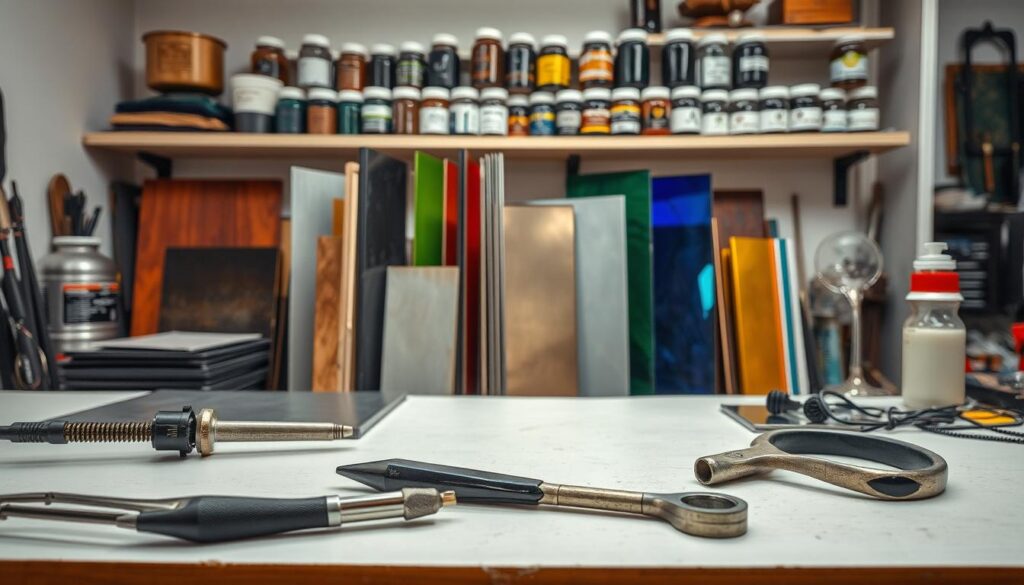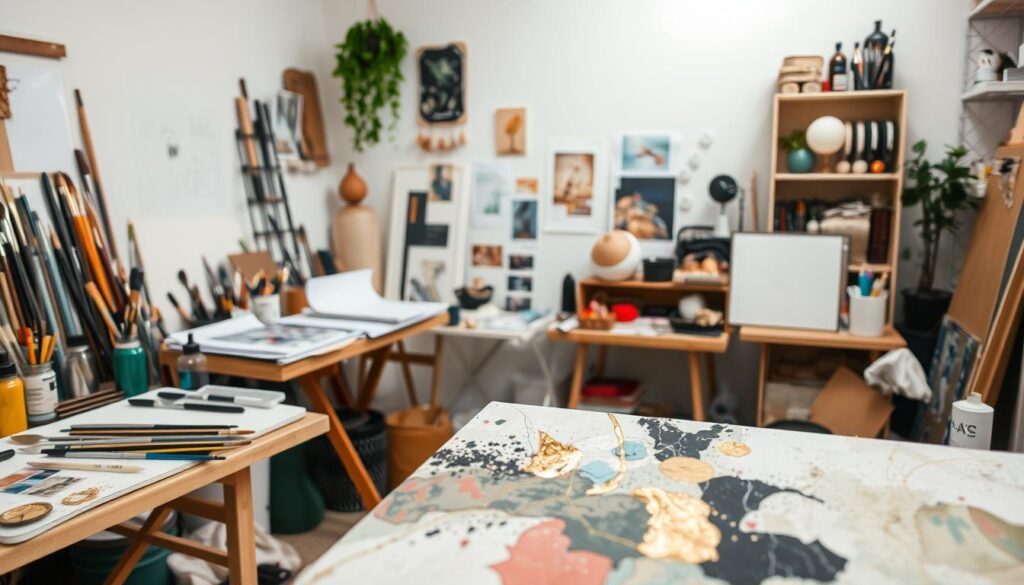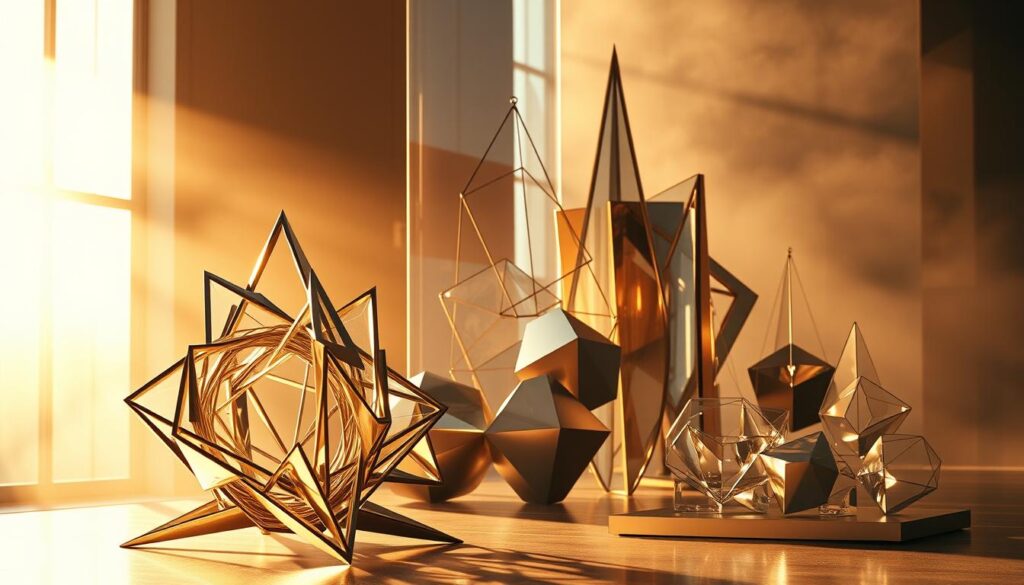In the world of contemporary art, the fusion of industrial materials with delicate elements creates stunning visual narratives. This guide dives into the innovative realm of mixed media, where artists blend contrasting textures to push creative boundaries.
Modern galleries and installations increasingly showcase these dynamic combinations. The interplay between strength and fragility offers endless possibilities for expression. However, mastering these techniques requires both skill and patience.
From understanding material fundamentals to crafting advanced compositions, this journey is both challenging and rewarding. Whether you’re an experienced artist or looking to expand your repertoire, this guide will inspire you to explore new horizons in your creative practice.
Introduction to Combining Metal and Glass in Mixed Media Art
Artists today are redefining boundaries by merging robust and fragile materials. This innovative approach has its roots in early 20th-century movements like Cubism and Surrealism. Pioneers such as Picasso and Rauschenberg experimented with different materials, laying the groundwork for modern mixed media art.
From traditional stained glass to contemporary industrial combinations, the evolution of this art form is fascinating. Today, creators blend functional metalwork with artistic glass applications, resulting in stunning visual narratives. This fusion not only enhances aesthetics but also challenges conventional artistic norms.
Successful gallery exhibitions have showcased the unique tension between metallic hardness and glass fragility. These pieces captivate audiences by balancing strength and delicacy. For instance, recent installations highlight how allowing artists to experiment with contrasts can lead to groundbreaking results.
However, working with these materials requires careful attention to safety. Sharp edges and high-temperature processes demand proper precautions. Always use protective gear and follow best practices to ensure a safe creative environment.
| Material | Characteristics | Applications |
|---|---|---|
| Metal | Durable, versatile, industrial | Structural support, texture creation |
| Glass | Fragile, transparent, reflective | Light effects, visual depth |
For more insights into blending these elements, explore metal wall art techniques. This resource offers valuable tips for integrating glass into your creations, ensuring your work stands out in the world of mixed media art.
Understanding the Basics of Metal and Glass in Art
The fusion of industrial strength and delicate beauty has long fascinated creators. These materials, though vastly different, complement each other in ways that push artistic boundaries. By understanding their properties and historical significance, you can unlock new dimensions in your work.
Properties of Metal and Glass
Metal is known for its durability and versatility. It can be molded, welded, or polished to create intricate designs. Glass, on the other hand, offers transparency and reflection, adding depth and light to any piece. Together, they create a dynamic interplay of textures and forms.
Historical Use of Metal and Glass in Art
Throughout history, artists have experimented with these materials. Medieval stained glass windows used lead came techniques to hold delicate glass pieces. The Art Nouveau movement brought innovations like Tiffany lamps, blending intricate metalwork with colorful glass.
In the 20th century, Bauhaus artists explored industrial materials, while Dale Chihuly revolutionized glass sculpture with metal armatures. Louise Nevelson’s steel-and-glass assemblages also stand as iconic examples of this fusion.
| Material | Properties | Historical Applications |
|---|---|---|
| Metal | Durable, versatile, industrial | Structural support, texture creation |
| Glass | Fragile, transparent, reflective | Stained glass, light effects |
By studying these historical examples, you can gain inspiration for your own creations. The interplay of strength and delicacy continues to captivate audiences and challenge artistic norms.
Essential Tools and Materials for Combining Metal and Glass
To achieve stunning results in your artwork, selecting the right tools and materials is crucial. The interplay between strength and delicacy demands careful consideration of every component. From metals to adhesives, each choice impacts the final piece.

Choosing the Right Metals
Metals like steel, aluminum, and copper are popular for their durability and versatility. Steel offers strength, while aluminum is lightweight and easy to shape. Copper adds a unique aesthetic with its warm tones. Consider the weight and finish of the metal to ensure it complements the glass.
Selecting the Appropriate Glass
Glass comes in various types, such as tempered, stained, and fused. Tempered glass is durable and safe, while stained glass adds vibrant colors. Fused glass allows for creative layering and texture. Choose glass that aligns with your vision and the intended use of the piece.
Adhesives and Fasteners
Bonding metal and glass requires the right adhesives or fasteners. Epoxy resins are ideal for heavy-duty applications, providing a strong, lasting bond. UV-curing adhesives are perfect for clear, seamless finishes. Mechanical fasteners like clamps or brackets offer flexibility for larger installations.
- Prepare surfaces thoroughly for optimal bonding. Clean and roughen metal, and ensure glass is free of dust.
- Use hidden mounting systems for a floating glass effect, adding a modern touch to your work.
- For outdoor installations, incorporate expansion joints to accommodate temperature changes.
- When creating functional glassware, opt for FDA-approved adhesives to ensure safety.
By mastering these techniques, you can elevate your creative process. For more insights, explore this guide on essential tools and materials to refine your approach.
Advanced Techniques for Combining Metal and Glass
Innovative art thrives on the fusion of contrasting elements. By mastering advanced methods, you can create pieces that captivate and inspire. These techniques allow you to push boundaries and explore new creative possibilities.
Layering Industrial and Delicate Elements
Layering is a powerful way to add depth and complexity to your work. Start by selecting materials that complement each other. For example, pair polished steel with translucent glass to create a striking contrast. Use adhesives or mechanical fasteners to secure the layers securely.
Consider the weight and balance of your piece. Heavy materials should be placed at the base for stability. Experiment with different arrangements to find the most visually appealing composition.
Creating Texture with Industrial and Delicate Elements
Texture adds tactile interest to your artwork. Use tools like grinders or sandblasters to create patterns on metal surfaces. For glass, try etching or fusing techniques to achieve unique textures.
Combining rough metal with smooth glass can create a dynamic visual effect. This contrast draws the viewer’s eye and adds depth to your piece. Always test your techniques on scrap materials before applying them to your final work.
Incorporating Found Objects
Using found objects adds a unique, personal touch to your art. Industrial scraps, like rusted metal or broken glass, can be upcycled into stunning pieces. This approach not only reduces waste but also adds historical or cultural significance to your work.
- Stabilize rusted objects before embedding them in glass to ensure longevity.
- Encapsulate historical artifacts to preserve their story while adding artistic value.
- Consider legal and ethical considerations when using found objects.
Artists like David Chihuly have successfully incorporated nautical metals with glass, creating iconic pieces. Let these examples inspire you to experiment with unconventional materials in your own work.
Tips for Success in Mixed Media Art
Mastering the art of blending industrial and delicate elements requires careful planning and execution. Whether you’re a seasoned artist or a beginner, these tips will help you refine your process and avoid common pitfalls.

Planning Your Composition
Start by sketching your ideas to visualize the final piece. Consider the balance between materials and how they interact. For example, heavy elements should be placed at the base for stability.
Think about the environment where your artwork will be displayed. Outdoor installations require materials that withstand weather changes. Indoor pieces can focus more on aesthetics.
Experimenting with Different Techniques
Don’t be afraid to try new methods. Layering materials can add depth, while texture contrasts create visual interest. Test your ideas on smaller pieces before committing to a large project.
Explore adhesives and fasteners that suit your materials. Epoxy resins work well for strong bonds, while UV-curing adhesives offer a seamless finish.
Avoiding Common Mistakes
One of the biggest mistakes is ignoring material compatibility. Thermal expansion mismatches can lead to cracks or breaks. Always test materials under similar conditions to your final setup.
Proper ventilation is crucial when working with metal fuming techniques. Glass stress-testing protocols should also be followed to ensure durability.
- Analyze failed public art installations to learn what went wrong.
- Review insurance considerations for fragile works to protect your investment.
Examples of Successful Mixed Media Artworks
Exploring the intersection of strength and fragility opens doors to artistic innovation. Many creators have mastered the art of blending robust and delicate elements, producing iconic works that inspire and challenge.
Famous Artists Who Blend Industrial and Delicate Materials
Preston Singletary’s Tlingit-inspired works showcase the harmony of cultural heritage and modern techniques. His use of glass and metal reflects traditional stories in a contemporary light.
Toots Zynsky’s filet de verre with metal threads demonstrates how delicate glass can be enhanced with industrial accents. Her pieces are celebrated for their vibrant colors and intricate details.
Dale Chihuly’s chandelier engineering is a testament to the fusion of art and architecture. His large-scale installations combine glass and metal to create breathtaking visual experiences.
Analyzing Their Techniques
Ginny Ruffner’s torchworked glass and metal hybrids reveal her mastery of heat and precision. Her work often incorporates found objects, adding layers of meaning to her art.
Historic pieces like Rauschenberg’s Combines highlight the challenges of conserving mixed media art. These works require careful handling to preserve their integrity over time.
| Artist | Technique | Key Materials |
|---|---|---|
| Preston Singletary | Tlingit-inspired glasswork | Glass, metal |
| Toots Zynsky | Filet de verre with metal threads | Glass, metal threads |
| Dale Chihuly | Chandelier engineering | Glass, steel |
| Ginny Ruffner | Torchworked hybrids | Glass, metal, found objects |
By studying these artists, you can gain insights into their materials techniques and apply them to your own work. Their innovative approaches continue to shape the world of contemporary art.
Experimenting with Unconventional Materials
Breaking away from traditional materials opens up a world of creative possibilities. By exploring unconventional elements, you can create unique artworks that stand out. This approach not only challenges artistic norms but also introduces new dimensions to your work.
Pushing the Boundaries of Mixed Media
One way to innovate is by incorporating meteorite iron inlay techniques into glass. This method adds a cosmic touch to your pieces, blending ancient materials with modern artistry. Another exciting approach is using ferrofluid patterns under glass, creating dynamic, fluid designs that captivate viewers.
Archaeological replication patinas offer another layer of depth. These techniques mimic ancient weathering, giving your work a timeless quality. Laser-etched metal under dichroic glass is another advanced method, producing vibrant, color-shifting effects that enhance visual appeal.
Creating Unique Textures and Effects
Nano-coating applications are revolutionizing surface treatments. These coatings add durability and unique visual effects, making your work both functional and striking. Experimenting with different textures can transform a simple piece into a masterpiece.
- Use meteorite iron inlays for a celestial aesthetic.
- Explore ferrofluid patterns for fluid, dynamic designs.
- Apply archaeological patinas for a weathered, ancient look.
- Incorporate laser-etched metal for vibrant, color-shifting effects.
- Experiment with nano-coatings for durable, visually stunning surfaces.
By embracing these unconventional methods, you can push the boundaries of your art. Each technique offers a new way to express your creativity and captivate your audience.
Conclusion: Elevating Your Art with Metal and Glass
Pushing creative boundaries with unconventional materials can transform your artistic practice. Throughout this guide, we’ve explored key technical breakthroughs that allow you to blend strength and delicacy seamlessly. These methods empower you to develop signature material combinations that set your work apart.
Consider pursuing professional certification opportunities to refine your skills further. Certifications not only enhance your credibility but also open doors to new artistic networks. Staying updated with emerging technologies in material science can also give you a competitive edge.
For those ready to take the next step, investing in an advanced studio setup is crucial. Proper tools and resources ensure you can experiment freely and safely. Whether you’re crafting intricate pieces or large installations, the right environment makes all the difference.
Embrace the journey of mastering mixed media and let your art speak volumes. The fusion of contrasting elements offers endless possibilities for innovation and expression.
